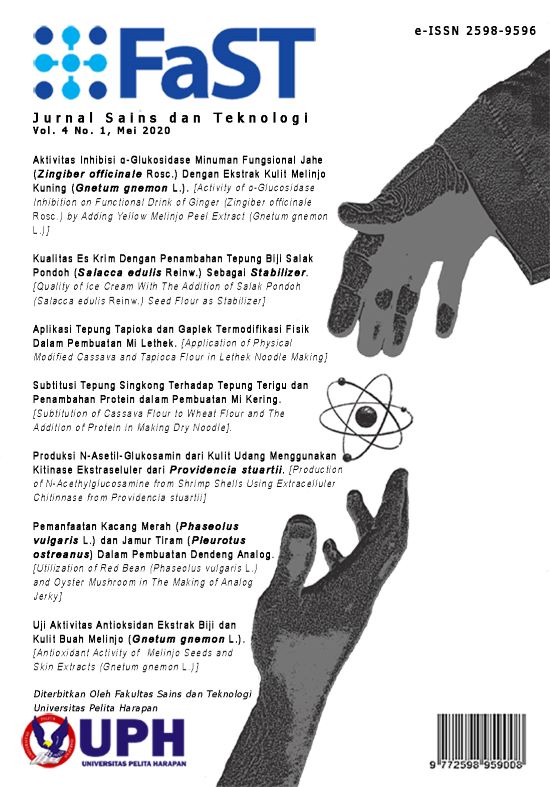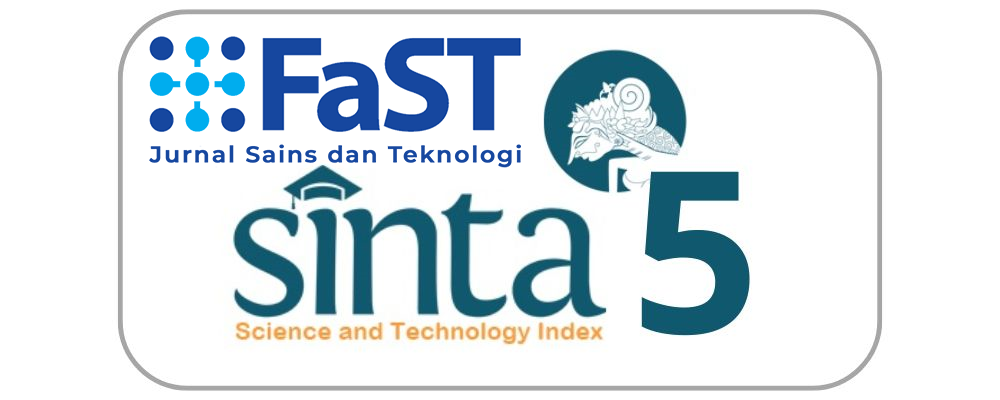APLIKASI TEPUNG TAPIOKA DAN GAPLEK TERMODIFIKASI FISIK DALAM PEMBUATAN MI LETHEK
Keywords:
Gaplek, guar gum, lethek noodle, physical modification, tapiocaAbstract
Lethek noodles are Yogyakarta's special food made from a mixture of cassava flour and tapioca flour. The application of tapioca flour and cassava chips as a result of the physical modification of the multi-cycle cooling-heating has not been carried out in the making of lethek noodles. The aim of this study was to apply physical modified tapioca and cassava flour and guar gum in the making of lethek noodles and determine their effects on the physical characteristics of lethek noodles. Physical modification of tapioca and cassava flour is done by heating-cooling 2 and 3 cycles. The heating process is carried out using an autoclave at 121ºC for 30 minutes, then followed by cooling at 4ºC for 24 hours. The study was designed with a Completely Randomized Design with variations in the ratio of tapioca flour and cassava chips modified (25:75, 50:50, and 75:25) and the concentration factor of guar gum (0%; 0.5%; 1%; 1.5 %). The results showed that the amylose content of physically modified cassava flour was higher (72.04%) than physically modified cassava flour (49.15%). The more modification of tapioca flour added, the lower cooking loss and the higher hardness of lethek noodles. The higher concentration of guar gum, the lower cooking loss and hardness of lethek noodles. Therefore, it can be stated that physical modified tapioca and gaplek flour can be applied in the making of lethek noodles and the best lethek noodles was made from the ratio of physical modified tapioca and cassava flour 75:25 and guar gum concentration of 1%.
References
Afifah, N. and Ratnawati, L. 2017. Quality assesment of dry noodles made from blend of mocaf flour, rice flour and corn flour. IOP Conf. Series: Earth and Environmental Science 101:1-9. Aluyor, E.O. and Okwundu, O.S. 2015. Development of whole cassava based instant noodles. International Journal of Agriculture and Earth Science 1(8):34-47. Aminullah, Muhandri, T., dan Subarna. 2019. Kajian penambahan guar gum, tawas, dan air terhadap karakteristik mutu fisik mi jagung basah metode ekstrusi. Jurnal Pertanian 10(1):36-42. Andarwulan, N., Kusnandar, F., dan Herawati. 2011. Analisis Pangan. Jakarta: Dian Rakyat. Anugrahati, N.A., Pranoto, Y., Marsono, Y., and Marseno, D.W. 2017. Physicochemical properties of rice (Oryza sativa L.) flour and starch of two Indonesian rice varieties differing in amylose content. International Food Research Journal 24(1):108-113. AOAC. 2012. “Official Methods of Analysis. Association of Official Analytical Chemists”. Washington: Benjamin Franklin Station. Budi, F.S., Hariyadi, P., Budijanto, S., dan Syah, D. 2017. Kristalinitas dan kekerasan beras analog yang dihasilkan dari proses ekstrusi panas tepung jagung. Jurnal Teknologi dan Industri Pangan 28(1):46-54. Cham, S. and Suwannaporn, P. 2010. Effect of hydrothermal treatment of rice on various rice noodles quality. Journal of Cereal Science 51:284-291. Chauhan, A., Saxena, D.C., and Singh, S. 2017. Effect of hydrocolloids on microstructure, texture and quality characteristics of gluten-free pasta. Journal of Food Measurement and Characterization 11(3):1188-1195. Diniyah, N., Subagio, A., Sari, E.N.L., dan Yuwana, N. 2018. Sifat fisikokimia, dan fungsional pati dari MOCAF (Modified Cassava Flour) varietas Kaspro dan Cimanggu. Jurnal Penelitian Pascapanen Pertanian 15(2):80-90. Effendi, Z., Surawan, F.E.D., dan Sulastri, Y. 2016. Sifat fisik mie basah berbahan dasar tepung komposit kentang dan tapioka. Jurnal Agroindustri 6(2):57-64. Ezeigbo, O.R., Ukabi, C.F., Ike-Amadi, C.A., and Ekaiko, M.U. 2015. Determination of starch and cyanide contents of different species of fresh cassava tuber in Abia State, Nigeria. British Biotechnology Journal 6(1):10-15. Fari, M.J.M., Rajapaksa, D., and Ranaweera, K.K.D.S. 2011. Quality characteristics of noodles made from selected varieties of Sri Lankan rice with different physicochemical characteristics. Journal of the National Science Foundation of Sri Lanka 39(1):53-60. Husniati, Siti N., dan Ryan P. 2015. Aplikasi gluten enkapsulasi pada proses pembuatan mie tapioka. Biopropal Industri 6(1):29-36. Indrianti, N., Kumalasari, R., Ekafitri, R., dan Darmajana, D.A. 2013. Pengaruh penggunaan pati ganyong, tapioka, dan mocaf sebagai bahan substitusi terhadap sifat fisik mie jagung instan. Agritech 33(4):391-398. Kaur, A., Shevkani, K., Singh, N., Sharma, P., and Kaur, S. 2015. Effect of guar gum and xanthan gum on pasting and noodle-making properties of potato, corn and mung bean starches. Journal of Food Science and Technology 52(12): 8113-8121. Koswara, S. 2013. “Teknologi Pengolahan Umbi-Umbian”. SEAFAST Center IPB, Bogor. Kraithong, S., Lee, S., and Rawdkuen, S. 2019. The influence of hydrocolloids on the properties organic red jasmine rice noodles, namely on antioxidant activity, cooking, texture, and sensory properties. Starch”Stärke 71:1-9. Kusnandar, F, Hastuti, H.P., dan Syamsir, E. 2015. Pati resisten sagu hasil proses hidrolisis asam dan autoclaving-cooling. Jurnal Teknologi dan Industri Pangan 26(1):56-62. Lawless, H. dan Heymann. H. 2010. “Sensory Evaluation of Food Principles and Practices” 2nd Edition. New York: Springer. Mandei, J.H. 2018. Penggunaan pati sagu termodifikasi dengan Heat Moisture Treatment sebagai bahan substitusi untuk pembuatan mi kering. Jurnal Penelitian Teknologi Industri 8(1):59-73. Muhandri, T. dan Palupi, N.S. 2013. Karakteristik mi basah jagung akibat pengaruh laju pengumpanan dan penambahan guar gum. Jurnal Teknologi dan Industri Pangan 24(1):110-114. Nazhrah, Julianti, E., dan Lubis, L.M. 2014. Pengaruh proses modifikasi fisik terhadap karakteristik pati dan produksi pati resisten dari empat varietas ubi kayu (Manihot esculenta). Jurnal Rekayasa Pangan dan Pertanian 2(2):1-9. Nielsen, S.S. 2010. “Food Analysis Laboratory Manual 4th ed”. New York: Springer Science. Nugroho, A., Ainuri, M., dan Khuriyati, N. 2015. Reduksi pemborosan untuk perbaikan value stream produksi “mi lethek” menggunakan pendekatan lean manufacturing. Agritech 35(2):205-211. Rahman, S. 2018. “Teknologi Pengolahan Tepung dan Pati Biji-bijian Berbasis Tanaman Kayu”. Yogyakarta: Deepublish. Ratnawati, L. dan Afifah, N. 2018. Pengaruh penggunaan hidrokoloid terhadap kualitas mi non gandum. Jurnal Pangan 27(1):43-54. Ratnawati, L. dan Afifah, N. 2018. Pengaruh penggunaan guar gum, carboxymethylcellulose (CMC) MOCAF, tepung beras dan tepung jagung. Pangan 27(1):43-54. Rogers, L. 2017. “Discrimination Testing in Sensory Science”. United Kingdom: Woodhead Publishing. Shaliha, L.A., Abduh, S.B.M., dan Hintono, A. 2017. Aktivitas antioksidan, tekstur dan kecerahan ubi jalar ungu (Ipomoea batatas) yang dikukus pada berbagai lama waktu pemanasan. Jurnal Aplikasi Teknologi Pangan 6(4):141-144. Srikaeo, K., Laothongsan, P., and Lerdluksamee, C. 2018. Effects of gums on physical properties, microstructure and starch digestibility of dried-natural fermented rice noodles. International Journal of Biological Macromolecules 109:517-523. Sugiyono, Setiawan, E., Syamsir, E., dan Sumekar, H. 2011. Pengembangan produk mi kering dari tepung ubi jalar (Ipomoea batatas) dan penentuan umur simpannya dengan metode isoterm sorpsI. Jurnal Teknologi dan Industri Pangan 22(2):164-170. Udoro, E.O., Kehinde, A.T., Olasunkanmi, S.G., and Charles, T.A. 2014. Studies on the physicochemical, functional and sensory properties of gari processed from dried cassava chips. J. Food Process Technol. 5(1):1-8. Yanetritien. 2018. Modifikasi fisik tepung dan siklus pengukusan-pendinginan dalam pembuatan mi lethek. Skripsi. Universitas Pelita Harapan, Karawaci, Tangerang. Yuliani, H. Yuliana, N.D., dan Budijanto, S. 2015. Formulasi mi kering sagu dengan substitusi tepung kacang hijau. Agritech 35(4): 387-395.
Downloads
Published
Issue
Section
License
“Authors who publish with this journal agree to the following terms:
1) Authors retain copyright and grant the journal right of first publication with the work simultaneously licensed under a Creative Commons Attribution License (CC-BY-SA 4.0) that allows others to share the work with an acknowledgement of the work's authorship and initial publication in this journal.
2) Authors are able to enter into separate, additional contractual arrangements for the non-exclusive distribution of the journal's published version of the work (e.g., post it to an institutional repository or publish it in a book), with an acknowledgement of its initial publication in this journal.
3) Authors are permitted and encouraged to post their work online (e.g., in institutional repositories or on their website). The final published PDF should be used and bibliographic details that credit the publication in this journal should be included.”



